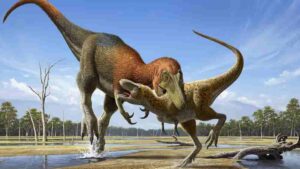
A new analysis of fossils believed to be juveniles of T. rex now shows they were adults of a small tyrannosaur, with narrower jaws, longer legs, and bigger arms than T. rex. The species, Nanotyrannus lancensis, was first named decades ago but later reinterpreted as a young T. rex.
The first skull of Nanotyrannus was found in Montana in 1942, but for decades, paleontologists have gone back and forth on whether it was a separate species, or simply a juvenile of the much larger T. rex.
Dr Nick Longrich, from the Milner Centre for Evolution at the University of Bath (UK), and Dr Evan Saitta, from the University of Chicago (USA) re-analysed the fossils, looking at growth rings, the anatomy of Nanotyrannus, and a previously unrecognized fossil of a young T. rex.
Measuring the growth rings in Nanotyrannus bones, they showed that they became more closely packed towards the outside of the bone — its growth was slowing. It suggests these animals were nearly full size; not fast-growing juveniles.
Modelling the growth of the fossils showed the animals would have reached a maximum of around 900-1500 kilograms and five metres — about 15 per cent of the size of the giant T. rex, which grew to 8,000 kilograms and nine metres or more.
The researchers have published their findings in Fossil Studies.
“When I saw these results I was pretty blown away,” said Longrich. “I didn’t expect it to be quite so conclusive.
“If they were young T. rex they should be growing like crazy, putting on hundreds of kilograms a year, but we’re not seeing that.
“We tried modeling the data in a lot of different ways and we kept getting low growth rates. This is looking like the end for the hypothesis that these animals are young T. rex.”
Supporting the existence of distinct species, the researchers found no evidence of fossils combining features of both the Nanotyrannus and T. rex – which would exist if the one turned into the other. Every fossil they examined could be confidently identified as one species or the other.
Neither did the patterns of growth in other tyrannosaurs fit with the hypothesis that these were young T. rex.
Dr Longrich said: “If you look at juveniles of other tyrannosaurs, they show many of the distinctive features of the adults. A very young Tarbosaurus – a close relative of T. rex – shows distinctive features of the adults.
“In the same way that kittens look like cats and puppies look like dogs, the juveniles of different tyrannosaurs are distinctive. And Nanotyrannus just doesn’t look anything like a T. rex.
“It could be growing in a way that’s completely unlike any other tyrannosaur, or any other dinosaur- but it’s more likely it’s just not a T. rex.”
But that raises a mystery — if Nanotyrannus isn’t a juvenile Tyrannosaurus, then why hasn’t anyone ever found a young T. rex?
“That’s always been one of the big questions. Well, it turns out we actually had found one,” said Longrich. “But the fossil was collected years ago, stuck in a box of unidentified bones in a museum drawer, and then forgotten.”
The research led Longrich and co-author Evan Saitta to a previous fossil discovery, stored in a museum in San Francisco which they identified as a juvenile Tyrannosaurus.
That young T. rex is represented by a skull bone — the frontal bone — with distinctive features that ally it with Tyrannosaurus, but which aren’t seen in Nanotyrannus. It comes from a small animal, one with a skull about 45 cm long and a body length of around 5 metres.
Dr Longrich said: “Yes, it’s just one specimen, and just one bone, but it only takes one. T. rex skull bones are very distinctive, nothing else looks like it. Young T. rex exist, they’re just incredibly rare, like juveniles of most dinosaurs.”
The researchers argue these findings are strong evidence that Nanotyrannus is a separate species, one not closely related to Tyrannosaurus. It was more lightly-built and long-limbed than its thick-set relative. It also had larger arms, unlike the famously short-armed T. rex.
“The arms are actually longer than those of T. rex. Even the biggest T. rex, has shorter arms and smaller claws than in these little Nanotyrannus. This was an animal where the arms were actually pretty formidable weapons. It’s really just a completely different animal — small, fast, agile.
“T. rex relied on size and strength, but this animal relied on speed.”
The long arms and other features suggest it was only distantly related to T. rex – and may have sat outside the family Tyrannosauridae, which T. rex is part of, in its own family of predatory dinosaurs.
The new study is the latest in a series of publications on the problem, going back decades.
Longrich said: “Nanotyrannus is highly controversial in paleontology. Not long ago, it seemed like we’d finally settled this problem, and it was a young T. rex.
“I was very skeptical about Nanotyrannus myself until about six years ago when I took a close look at the fossils and was surprised to realise we’d gotten it wrong all these years.”
The authors suggest that, given how difficult it is to tell dinosaurs apart based on their often-incomplete skeletons, we may be underestimating the diversity of dinosaurs, and other fossil species.
Longrich said: “It’s amazing to think how much we still don’t know about the most famous of all the dinosaurs. It makes you wonder what else we’ve gotten wrong.”
Reference:
Nicholas R. Longrich, Evan T. Saitta. Taxonomic Status of Nanotyrannus lancensis (Dinosauria: Tyrannosauroidea)—A Distinct Taxon of Small-Bodied Tyrannosaur. Fossil Studies, 2024; 2 (1): 1 DOI: 10.3390/fossils2010001
Note: The above post is reprinted from materials provided by University of Bath.










